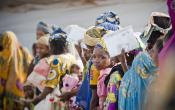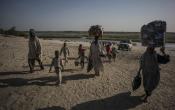Cameroon
Operation: Cameroon
Location
{"longitude":12,"latitude":5,"zoom_level":0}
Latest update of camps and office locations 21 Nov 2016. By clicking on the icons on the map, additional information is displayed.
Key Figures
| 2017 planning figures | |
| 100% | of people of concern will be registered on an individual basis |
| 100% | of people of concern who report sexual and gender-based violence (SGBV) incidents will receive appropriate support |
| 260,000 | people of concern will receive shelter support |
| 80,400 | people of concern will receive input for livelihoods activities |
| 68,900 | registered refugee children will be enrolled in primary education |
| 2015 end-year results | |
| 49% | of CAR refugee children enrolled in primary school |
| 35,000 | CAR refugee households received core relief items |
| 3,000 | IDPs received shelter support |
| 90% | of primary school-aged Nigerian refugee children enrolled |
Latest Updates and Related Links
People of Concern
66%
Increase in
2015
2015
| 2015 | 459,650 |
| 2014 | 276,265 |
| 2013 | 123,090 |

[["Refugees",327121],["Refugee-like situation",15852],["Asylum-seekers",5373],["IDPs",92657],["Returned IDPs",18636],["Others of concern",11]]
Loading ...
Budgets and Expenditure for Cameroon
< Back
2015
{"categories":[2012,2013,2014,2015,2016,2017],"budget":[20.6565492,23.58358842,81.27658602,114.697643602,98.62460251,94.244829039],"expenditure":[10.76662458,12.96600018,44.17872352,50.71501571,null,null]}
{"categories":[2012,2013,2014,2015,2016,2017],"p1":[19.83024575,22.80065742,80.48365484,107.653576378,89.4764597,87.794566424],"p2":[0.82630345,0.782931,0.79293118,0.843987224,1.885381,1.149999999],"p3":[null,null,null,null,null,null],"p4":[null,null,null,6.20008,7.26276181,5.300262616]}
{"categories":[2012,2013,2014,2015,2016,2017],"p1":[10.54988338,12.84369964,44.04089519,45.95148629,null,null],"p2":[0.2167412,0.12230054,0.13782833,0.207295,null,null],"p3":[null,null,null,null,null,null],"p4":[null,null,null,4.55623442,null,null]}
Loading ...
CHOOSE A YEAR
- 2014
- 2015
- 2016
- 2017
Working environment
Over the past two years, thousands of refugees from neighbouring countries have arrived in Cameroon. Over 259,000 refugees from the Central African Republic (CAR) are hosted in the East, Adamawa and North regions; 21,000 refugees and asylum-seekers in urban areas and about 73,745 Nigerian refugees in the Far North region. 192,000 remain internally displaced in the Far North.70 per cent of Central African refugees are settled within host communities across 300 villages, often located deep in the forest with limited access to humanitarian actors and government counterparts. Under these circumstances, ensuring a wide and coherent coverage of assistance and protection activities has become challenging. Refugees depend mainly on existing water, sanitation and hygiene (WASH), health and education infrastructures and services. The remaining 30 per cent are sheltered in the seven refugee sites where UNHCR and partners provide protection and multi-sectoral assistance.
Nigerian refugees are largely settled in the Far North region, an area affected by frequent Boko Haram incursions. Security measures are in place to restrict rebel incursions from both Nigeria and the Central African Republic into Cameroon, thus limiting the free movement of people and goods. Access to affected populations is also challenging, especially in the Far North region where the Government of Cameroon applies an encampment policy for refugees. 57,000 Nigerian refugees are accommodated in the Minawao camp where multi-sectoral services are also being provided by UNHCR and partners.
Key priorities
Refugees from the Central African Republic
As part of the search for durable solutions, UNHCR will focus on the gradual socio-economic integration of refugees. UNHCR will implement a self-reliance strategy to progressively increase the resilience of refugees and most vulnerable host communities, while reducing their dependence on humanitarian aid. The integration of refugees into national structures and support to an area-based development plan form the main components of the strategy. Development actors and administrative authorities will be increasingly involved in the response. UNHCR will coordinate possible returns once the pre-conditions for a safe and dignified return are in place.Nigerian refugees and IDPs
UNHCR will continue its advocacy efforts with national authorities to improve access to asylum and respect for the principle of non-refoulement, while taking into account national security measures. Screening of new arrivals and border monitoring will be undertaken jointly with Cameroonian authorities. Protection monitoring in refugee and IDP hosting areas will be ensured through a network of partners and local authorities, supported by UNHCR staff.UNHCR and partners will continue to improve living standards for refugees in all sectors in the Minawao camp as well as the protection of all refugees in camps and host villages. In addition to protection assistance, IDPs will continue to benefit from shelter and core-relief items support as required. UNHCR will coordinate possible refugee returns under tripartite arrangements once the pre-conditions for a safe and dignified return are in place and support IDPs opting to return to their areas of origin.
In the event of funding shortfalls to invest in basic health, education and WASH infrastructure in refugee hosting areas, Cameroonian authorities may be less inclined to continue accommodating large numbers of refugees. This may result in increased pressure to repatriate refugees in non-conducive conditions.





